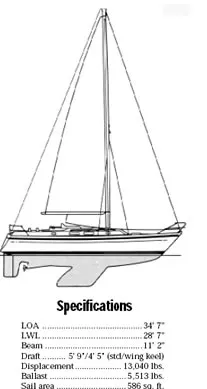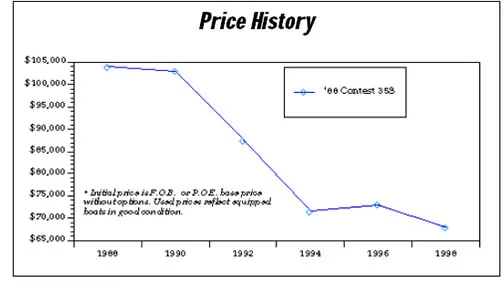
Conyplex, builder of the Contest 35S, is an established company that was a pioneer in fiberglass boat construction. In 1958, it began work on fiberglass Flying Dutchmans, and two years later introduced the Contest 25, its first cruiser. More than 5,000 boats have been built since, with about 600 of these being exported to the U.S. through Van Breems Holland Yachts of Westport, Connecticut.
The Contest 35S is a new design, introduced in 1988 to replace the earlier Contest 35.
Martinus Van Breems, who also invented and markets the Dutchman mainsail containment system, brought hull #22 of the Contest 35S to Newport, Rhode Island for Practical Sailor to test. This gave us a good opportunity to crawl through the boat and sail it in a variety of wind conditions.
Design
All Contest sailboats are designed by Dick Zaal, who for years was Conyplex’s in-house designer. Each displays certain trademarks: high freeboard, wooden rubrails, and low cabin profiles.
The Contest 35S conforms to the traditional Zaal style. The molded cockpit coaming that continues the line of the cabin all the way aft is certainly distinctive. It provides very comfortable back support, though the affect on appearance is not all that attractive, creating as it does a feeling of greater mass high and aft than one is accustomed to seeing on aft cockpit boats.
The hull form is powerful, with relatively full sections compared to many modern racer/cruisers. The moderate displacement-to-length ratio of 249 gives it reasonable speed for a cruising boat while retaining the ability to carry the amount of stores that are necessary for living aboard and short-term cruising.
Two keels are available. The standard keel is a cruising fin in which the foot is longer than the root (the section that attaches to the hull); the wing keel, which we tested, was developed in tank tests at the Marin Institute in the Netherlands and saves 1′ 4″ in draft.
The propeller shaft exits through a solid log rather than a strut, and though this increases wetted surface area somewhat, it is strong and also marginally improves directional stability. The rudder is hung on a full skeg—a smart feature on a cruising boat, providing that the skeg is well attached to the hull.
The rig is a conventional masthead sloop with double spreaders, high-aspect mainsail and the ability to carry large genoas. The boat we sailed had a fully battened main equipped with the Dutchman system, and Profurl furling gear on the headsail. These two devices make a boat of this size about as easy to sail as is possible.
Construction
Because Contest boats are cruisers, built without too much concern for weight, there is nothing exotic about their construction. The hull and deck structure of the 35S is built of chopped strand mat, cloth and woven roving, cored with end-grain balsa.
The pros and cons of balsa coring are debated endlessly. It is an excellent material for using in sandwich with fiberglass, creating a strong, lightweight structure. The likelihood of it absorbing water is problematical and not of immediate concern in a new boat. However, whereas the racing boat must, by necessity, incorporate weight-saving materials and construction techniques, there is no reason the slower cruising boat should compromise itself for weight. We like a single skin fiberglass hull for cruising, if for no other reason than it’s easier to repair than a cored hull. If you’re trying to patch a hole on the beach of some Third World country, or even in a Caribbean boatyard, you’ll appreciate working with solid fiberglass.
Conyplex assembles the hull and deck before building the interior; the opposite is the usual practice. The joint is glassed over with at least seven layers of cloth and also through-bolted. This is an extremely strong hull-to-deck joint that should never leak. By raising the deck a few inches above the joint, the joint, covered by a teak rubrail and stainless steel strip, is less vulnerable to damage from collision with pilings and other boats. This is a superb configuration, though again the raised deck increases apparent freeboard.
Another feature of the Contest that we like is the all-wood, built-up interior. All furniture is marine grade plywood fiberglassed to the hull—no molded
fiberglass pans that are cold, noisy and may prohibit access to some parts of the hull. A further advantage of wood is the ability to customize it later; fiberglass simply doesn’t allow as much flexibility to change interior plans. Then again, for the price of a Contest, you expect an all-wood interior.

Hardwood stringers and floors are fiberglassed to the hull to increase the rigidity of the structure; in a mass production boat these might be incorporated into the fiberglass pan or liner, along with furniture foundations.
Each Contest is delivered with a Lloyd’s certificate, which means it has been constructed under the specific rules of that agency, and under the watchful eye of its inspectors. This costs the builder extra money—about $800—which is passed along to the buyer, but if you’re looking for a quality boat to own a long time, it’s probably worth it.
Interior
The layout of the Contest 35S is straightforward, with a few unexpected wrinkles.
The companionway hatch slides into a nice seahood, and though a small opening offers safety offshore, the shallow depth of the hatch and the orientation of the ladder make the trip below a little tight—one is careful not to hit his head.The forward V-berths are 6′ 7″ long with shelves port and starboard. The hull is covered with an upholstery fabric; given the finely crafted joinerwork throughout this boat, we expected to find a wood ceiling in the bows, but were not overly disappointed as the fabric insulates moisture and sound, is pleasant to the touch, and does save weight over wood. Headroom here is 5′ 11″.
The saloon features a 6′ 6″ settee to port and an Lshaped settee to starboard, both of which will make good sea berths when fitted with lee cloths. Headroom in the saloon ranges from 6′ 3″ aft down to 6′ 1- 1/2″ forward.
The navigation station is the right size for this boat, with enough space to spread charts folded once. Opposite is the galley, which we thought was a bit on the small side. There isn’t much counter space for food preparation and even Martinus admitted that the icebox is small by U.S. standards.
The head is aft and to port, under the bridge deck. There is an access door to the double berth stateroom under the cockpit, giving each person his or her own side to get out of bed. The wet locker aft of the head is difficult to access; Martinus said the company was looking at other uses of this space, possibly a freezer. The matte finish varnishing of the teak is nicely done. Dutch tiles around the galley are a Van Breems trademark. There are numerous stowage compartments, which are always appreciated. We were again surprised that the hull inside many of these compartments was merely spray painted—we expected wood or at least fabric, and we can only speculate that even top-end builders must sometimes find places to save costs. Overall, however, the Contest 35S is beautifully finished with much attention to detail.
Performance
We sailed the 35S in a variety of wind conditions ranging from light to moderate. The first thing we noticed was how well balanced it was under mainsail and #2 furling genoa. Hard on the wind, it was possible to take our hands off the Whitlock wheel; there was little tendency to round up. A little weather helm, of course, is actually desirable, as it functions not only as a safety feature (allowing the boat to round up and spill wind in a strong gust), but also helps the helmsman develop feel for the optimum angle off the wind. This observation was corroborated by tests of the boat reported in the British magazine Yachting Monthly, in which the author wrote, “If there is a criticism, it is that she was a little reticent about telling the helmsman when she was precisely in the groove.”
Other than this, the boat tracked nicely and easily, remaining under control at all times. We found it a pleasure to steer, tacking through about 85 degrees and making about seven knots on a reach in 12 to 15 knots of wind, and about six knots beating in relatively calm bay waters. Diesel auxiliary power is a 28-hp. Volvo diesel, which is well-insulated and equipped with a flexible drive coupling to minimize vibration. While running, it was quiet and smooth, a real pleasure for motoring and/or motor sailing. Our boat had a three bladed prop, which didn’t help sailing performance, but made backing out of slips a thoroughly manageable process.

Conclusion
To our mind, the Contest 35S is not an exciting boat in terms of looks or performance. Rather it is a solid, well-built, conservative cruiser that is tastefully appointed for comfortable living aboard. It is an able sailer that should carry a crew safely to most any place they wish to go. The Dutch are known for quality workmanship, and the Contest 35S is no exception.






































